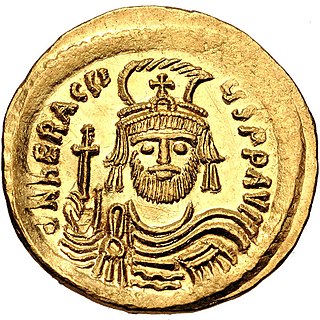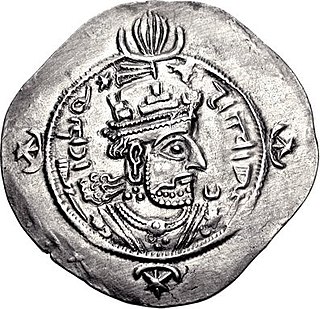
Heraclius was Byzantine emperor from 610 to 641. His rise to power began in 608, when he and his father, Heraclius the Elder, the exarch of Africa, led a revolt against the unpopular usurper Phocas.
The 610s decade ran from January 1, 610, to December 31, 619.

Year 619 (DCXIX) was a common year starting on Monday of the Julian calendar. The denomination 619 for this year has been used since the early medieval period, when the Anno Domini calendar era became the prevalent method in Europe for naming years.

Kavad II was the Sasanian King of Kings of Iran briefly in 628.

Khosrow II, commonly known as Khosrow Parviz, is considered to be the last great Sasanian king (shah) of Iran, ruling from 590 to 628, with an interruption of one year.

Shahrbaraz, was shah (king) of the Sasanian Empire from 27 April 630 to 9 June 630. He usurped the throne from Ardashir III, and was killed by Iranian nobles after forty days. Before usurping the Sasanian throne he was a spahbed (general) under Khosrow II (590–628). He is furthermore noted for his important role during the climactic Byzantine–Sasanian War of 602–628, and the events that followed afterwards.
The Roman–Persian Wars, also known as the Roman–Iranian Wars, were a series of conflicts between states of the Greco-Roman world and two successive Iranian empires: the Parthian and the Sasanian. Battles between the Parthian Empire and the Roman Republic began in 54 BC; wars began under the late Republic, and continued through the Roman and Sasanian empires. A plethora of vassal kingdoms and allied nomadic nations in the form of buffer states and proxies also played a role. The wars were ended by the early Muslim conquests, which led to the fall of the Sasanian Empire and huge territorial losses for the Byzantine Empire, shortly after the end of the last war between them.

The SasanianEmpire or Sassanid Empire, also known as the Second Persian Empire or Neo-Persian Empire, was the last Iranian empire before the early Muslim conquests of the 7th–8th centuries AD. Named after the House of Sasan, it endured for over four centuries, from 224 to 651 AD, making it the second longest-lived Persian imperial dynasty, after the Arsacids. The Sasanian Empire succeeded the Parthian Empire, and re-established the Persians as a major power in late antiquity alongside its neighbouring arch-rival, the Roman Empire. The empire ended with the Arab conquest of Iran.
Heraclius' campaign of 622, erroneously also known as the Battle of Issus, was a major campaign in the Byzantine–Sasanian War of 602–628 by emperor Heraclius that culminated in a crushing Byzantine victory in Anatolia.

The Jewish revolt against Heraclius was part of the Byzantine–Sasanian War of 602–628 and is considered the last serious Jewish attempt to gain autonomy in Palaestina Prima prior to modern times.
Shahen or Shahin was a senior Sasanian general (spahbed) during the reign of Khosrow II (590–628). He was a member of the House of Spandiyadh.

The Battle of Antioch took place in 613 outside Antioch, Turkey between a Byzantine army led by Emperor Heraclius and a Persian Sassanid army under Generals (spahbed) Shahin and Shahrbaraz as part of the Byzantine–Sasanian War of 602–628. The victorious Persians were able to maintain a hold on the recently taken Byzantine territory. The victory paved the way for a further Sasanian advance into the Levant and Anatolia.

The Sasanian conquest of Jerusalem was a significant event in the Byzantine–Sasanian War of 602–628, having taken place in early 614. Amidst the conflict, Sasanian king Khosrow II had appointed Shahrbaraz, his spahbod, to lead an offensive into the Diocese of the East of the Byzantine Empire. Under Shahrbaraz, the Sasanian army had secured victories at Antioch as well as at Caesarea Maritima, the administrative capital of Palaestina Prima. By this time, the grand inner harbour had silted up and was useless, but the city continued to be an important maritime hub after Byzantine emperor Anastasius I Dicorus ordered the reconstruction of the outer harbour. Successfully capturing the city and the harbour had given the Sasanian Empire strategic access to the Mediterranean Sea. The Sasanians' advance was accompanied by the outbreak of a Jewish revolt against Heraclius; the Sasanian army was joined by Nehemiah ben Hushiel and Benjamin of Tiberias, who enlisted and armed Jews from across Galilee, including the cities of Tiberias and Nazareth. In total, between 20,000 and 26,000 Jewish rebels took part in the Sasanian assault on Jerusalem. By mid-614, the Jews and the Sasanians had captured the city, but sources vary on whether this occurred without resistance or after a siege and breaching of the wall with artillery. Following the Sasanians capture of Jerusalem tens of thousands of Byzantine Christians were massacred by the Jewish rebels.
In 615, during the ongoing war with the Byzantine Empire, the Sasanian army under spahbod Shahin invaded Asia Minor and reached Chalcedon, across the Bosporus from Constantinople. It was at this point, according to Sebeos, that Heraclius had agreed to stand down and was about ready to become a client of the Sasanian emperor Khosrow II, allowing the Roman Empire to become a Persian client state, as well as even allow Khosrow II to choose the emperor. The Sassanids had already captured Roman Syria and Palestine in the previous year. After negotiations with Byzantine Emperor Heraclius, a Byzantine ambassador was sent to Persian Shahanshah Khosrow II, and Shahin withdrew again to Syria.

The Byzantine–Sasanian War of 602–628 was the final and most devastating of the series of wars fought between the Byzantine / Roman Empire and the Sasanian Empire of Iran. The previous war between the two powers had ended in 591 after Emperor Maurice helped the Sasanian king Khosrow II regain his throne. In 602 Maurice was murdered by his political rival Phocas. Khosrow declared war, ostensibly to avenge the death of the deposed emperor Maurice. This became a decades-long conflict, the longest war in the series, and was fought throughout the Middle East: in Egypt, the Levant, Mesopotamia, the Caucasus, Anatolia, Armenia, the Aegean Sea and before the walls of Constantinople itself.
Nicetas or Niketas was the cousin of Emperor Heraclius. He played a major role in the revolt against Phocas that brought Heraclius to the throne, where he captured Egypt for his cousin. Nicetas remained governor of Egypt thereafter, and participated also in the Byzantine–Sassanid War of 602–628, but failed to stop the Sassanid conquest of Egypt ca. 618/619. He disappears from the sources thereafter, but possibly served as Exarch of Africa until his death.
Benjamin of Tiberias was a man of immense wealth, who enlisted and armed many soldiers during the Jewish revolt against Heraclius in the 7th century Palaestina province of the Byzantine Empire. The Persian force was joined by Benjamin of Tiberias, who enlisted and armed Jewish soldiers from Tiberias, Nazareth and the mountain cities of Galilee and together they marched on Jerusalem. Later, they were joined by the Jews of the southern parts of the country; and supported by a band of Arabs, the united forces took Jerusalem in 614 CE. Benjamin was one of the leaders of the revolt, actively participating in the Persian siege and capture of Jerusalem in 614. It is thought that the second leader Nehemiah ben Hushiel was appointed as ruler of Jerusalem.
The siege of Ctesiphon took place on 27 April 629 between the forces of Shahrbaraz and Ardashir III. Shahrbaraz managed to capture Ctesiphon with a small force, revealing to all the weakness of the Sasanian Empire.
Shahralanyozan was an Iranian officer who served as the military governor of Sasanian Egypt during the 620s.

Sasanian Egypt refers to the brief rule of Egypt and parts of Libya by the Sasanian Empire, following the Sasanian conquest of Egypt. It lasted from 618 to 628, until the Sasanian general Shahrbaraz made an alliance with the Roman Byzantine emperor Heraclius to have control over Egypt returned to him.










